#District Archaeology Society
Text
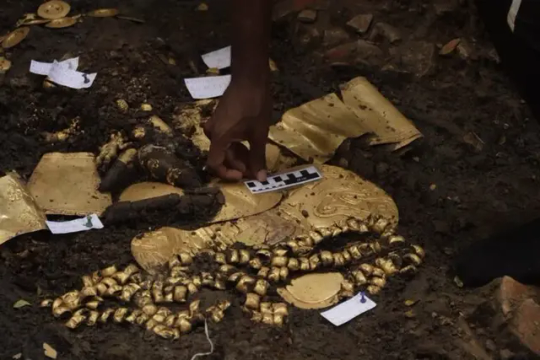
A Major Tomb With Gold and Ceramic Artifacts Discovered in Panama
In an archaeological find in the El Caño Archaeological Park, located in the district of Natá, province of Coclé, in Panama, a tomb has been discovered that sheds light on the sophisticated Coclé society of pre-Hispanic times.
The tomb thought to belong to a Coclé lord and dating back to 750 CE, was found to contain a wealth of funerary offerings, including ceramic and gold artifacts.
The El Caño Archaeological Park is well-known for its necropolis of tombs and stone monoliths that date back to 700–1000 CE. American explorer Hyatt Verrill first realized the importance of the site in 1925 when he discovered ancient monoliths beside the Rio Grande River.
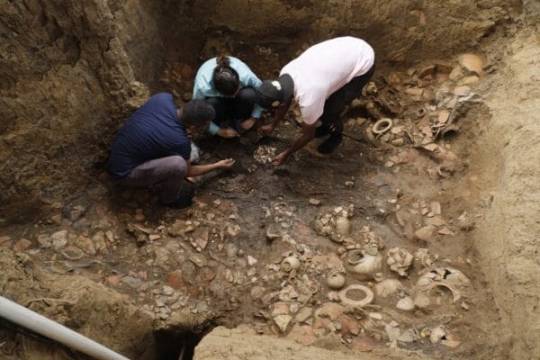
Linette Montenegro, National Heritage Director of the Ministry of Culture (MiCultura), explained that this discovery is part of the ongoing archeological project in the park.
The project, started in 2022 and financed through a cooperation agreement between the Ministry of Culture and the El Caño Foundation, aims to thoroughly explore Tomb No. 9 during the 2021-2024 campaigns.
The tomb’s contents, consisting of 5 pectorals, 2 belts of gold beads, 4 bracelets, 2 earrings in the shape of human figures, an earring in the shape of a double crocodile, 1 necklace of circular beads, two bells, bracelets, and a skirt made with dog teeth, and a set of bone flutes, is testimony to the cultural and social wealth of the Coclé society.
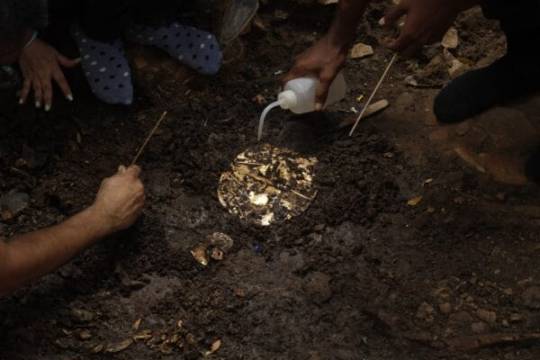
Dr. Julia Mayo, director of the El Caño Foundation and leader of the archaeological project since its inception in 2008, highlighted the importance of this discovery.
The collection, which probably belonged to a high-status adult male, represents a window into life and death in the Rio Grande chiefdom. The tomb, built around 750 A.D., is especially intriguing due to the presence of sacrificial attendants buried alongside the lord, indicating multiple and simultaneous burial practices.
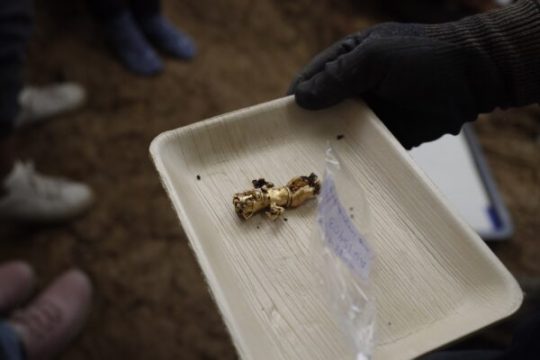
Dr. Mayo noted that the excavation process is ongoing, making it difficult to determine the exact number of individuals buried within the tomb. She said that this type of burial, known for burying a variable number of people in the same tomb, provides valuable information about the beliefs and funerary rituals of the Cocle society.
Dr. Mayo explained that the Coclé lord was buried in a face-down position, a customary practice in this culture, often atop the remains of a woman.
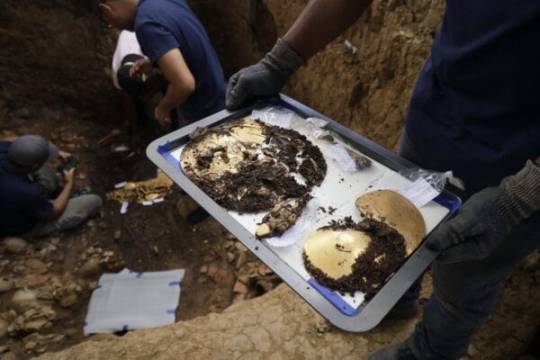
El Caño Archaeological Park, built around 700 A.D. and abandoned around 1000 A.D., has yielded significant archaeological discoveries. In addition to the known monoliths, the site includes a cemetery and a ceremonial area with wooden structures. This discovery stands out for its uniqueness and the insight it provides into Cocle society’s funerary practices.
By Oguz Buyukyildirim.
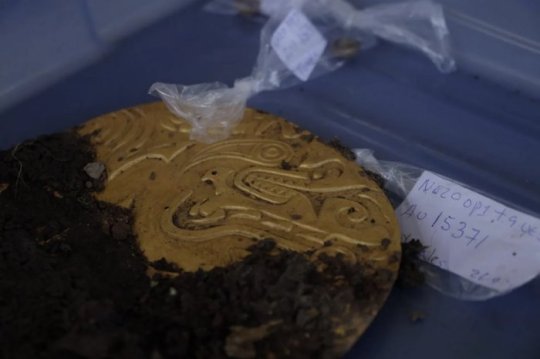
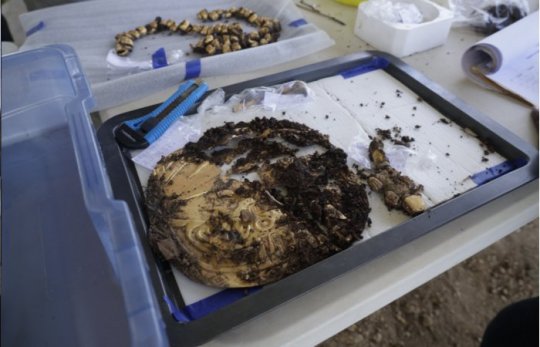
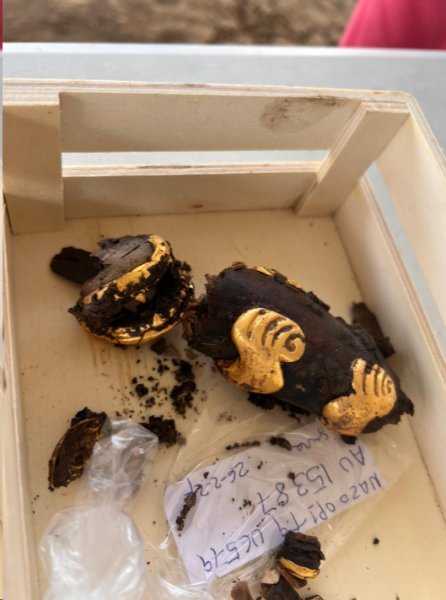
#A Major Tomb With Gold and Ceramic Artifacts Discovered in Panama#El Caño Archaeological Park#Coclé lord#ancient tomb#ancient grave#ancient necropolis#ancient artifacts#gold#gold artifacts#treasure#archaeology#archeolgst#history#history news#ancient history#ancient culture#ancient civilizations#Coclé society#pre-Hispanic times
93 notes
·
View notes
Photo

Map of especially metal-poor giant stars identified from Gaia DR3 data that shows, as a concentrated region (marked with a circke), the stars of the "poor old heart" of the Milky Way galaxy. The map shows the whole of the night sky in the same way that certain maps of the world show Earth's surface. In the center of the map is the direction towards the center of our home galaxy. Credit: H.-W. Rix / MPIA
Astronomers identify the ancient heart of the Milky Way galaxy
by Max Planck Society
A group of MPIA astronomers has managed to identify the "poor old heart of the Milky Way"—a population of stars left over from the earliest history of our home galaxy, which resides in our galaxy's core regions.
For this feat of "galactic archaeology," the researchers analyzed data from the most recent release of ESA's Gaia Mission, using a neural network to extract metallicities for two million bright giant stars in the inner region of our galaxy. The detection of these stars, but also their observed properties, provides welcome corroboration for cosmological simulations of the earliest history of our home galaxy.
Our home galaxy, the Milky Way, gradually formed over nearly the entire history of the universe, which spans 13 billion years. Over the past decades, astronomers have managed to reconstruct different epochs of galactic history in the same way that archaeologists would reconstruct the history of a city: Some buildings come with explicit dates of construction.
For others, the use of more primitive building materials or older building styles implies that they have come before, as does the situation where remnants are found underneath other (and thus newer) structures. Last but not least, spatial patterns are important—for many cities, there will be a central old town surrounded by districts that are clearly newer.
For galaxies, and in particular for our home galaxy, cosmic archaeology proceeds along very similar lines. The basic building blocks of a galaxy are its stars. For a small subset of stars, astronomers can deduce precisely how old they are. For example, this is true for so-called sub-giants, a brief phase of stellar evolution where a star's brightness and temperature can be used to deduce its age. ...
24 notes
·
View notes
Text
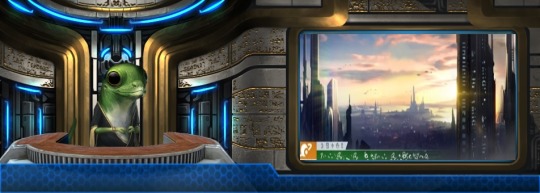
Hello, friends! I am your host Zedko and here is our latest edition of Republic News Update!

First on our agenda is the traveling Historical Exhibit and it's success within the @elepharchy ! Turn out was "well more then expected" said the exhibit's organizers, and even the number of virtual visitors - owing to the Elepharchy's virtual society - was nearly triple that of expectations.
As such, the Ministry of Galactic Affairs has announced that it's in talks with the @phlaalu, @pactargent and @guildsre among others to sponsor another Exhibit visit to their space. I am told those talks proceed well, with only minor details of routes and hyper-lane paths being behind the delays.

Secondly, of course, is the continued work on the Laxtara City expansion. While current expansion has been halted until the recent archaeological excavations are finished and cataloged, city planners say that the existing expansion tract is now being built upward, with "several dozen new districts already being completed" within the last solar week, so says one of the @elepharchy supervisory minds.
The Chancellor's Office expects the expansion will result in nearly 1,000,000 new hab units being finished within the next two months, well ahead of schedule even with the archaeological delays.

Last but never least, the @elconsystems crisis - it still remains a shadow over our nation and our Galaxy, indeed. The Ministry of Defense has confirmed that another few dozen ships have made it through @thylakindustrial borders to safety, carrying several hundred cramped but healthy Thylak evacuees.
Our friends in the Nocle Commonality - a splinter nation of the Elcon Systems - have been reporting on opportunities to free captured Thylak where possible, and have earned them the esteemed thanks of the Thylak emergency government on Marta II.
Minister of Defense Ka'plet held a meeting with Nocle officials today to discuss the ongoing efforts. "Our espionage efforts are of course, classified." he told reporters, "but I can confirm that our friends continue to supply us with interesting information on the Elcon's inner workings, including their own brutal suppression of their people."
Patrol Fleet officials say that the fleet alert condition will remain unchanged until the crisis is over, but will give all personnel ample leave time and in conjunction with working laws, will ensure rotations of shifts in a fair and standard manner so as not to encourage exhaustion.

That is the news for today, friends. It's a sunny and crisp day here on Laxtara. I am your host, Zedko, and I hope that you all have a wonderful rest of your day and a restful weekend full of friendship and kindness!
3 notes
·
View notes
Text
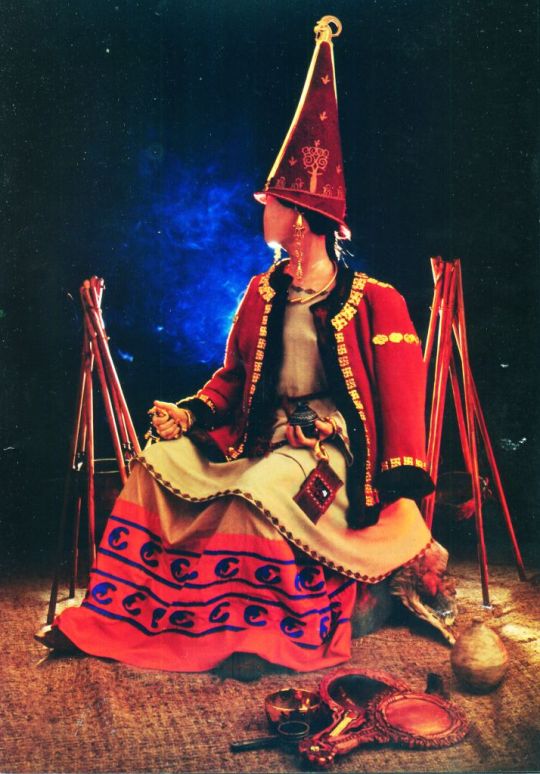
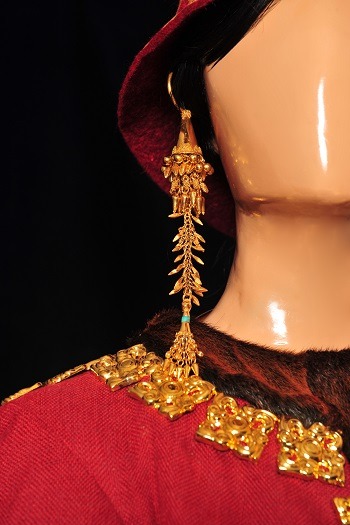
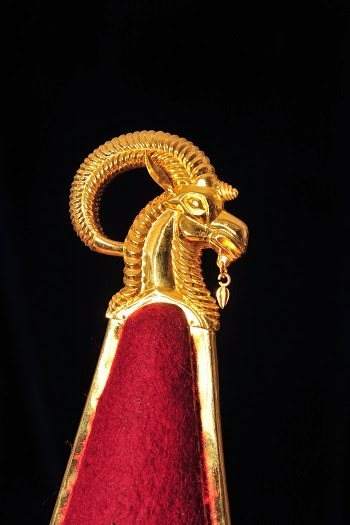
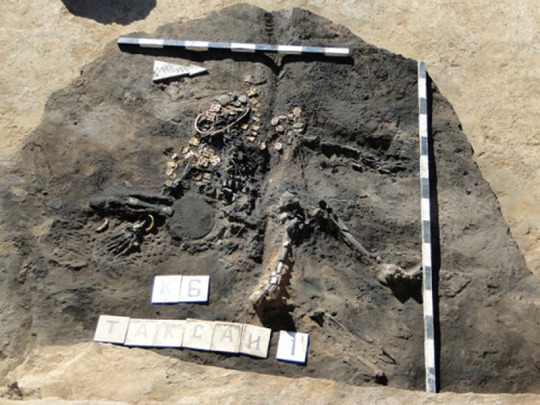
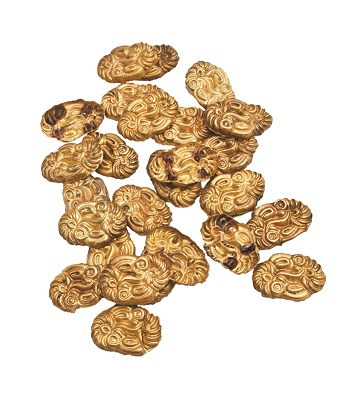


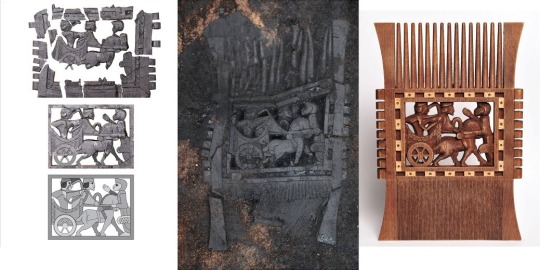
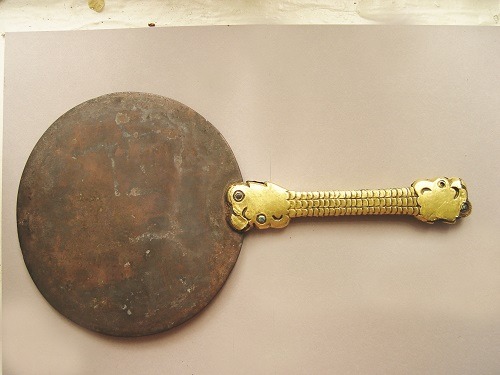

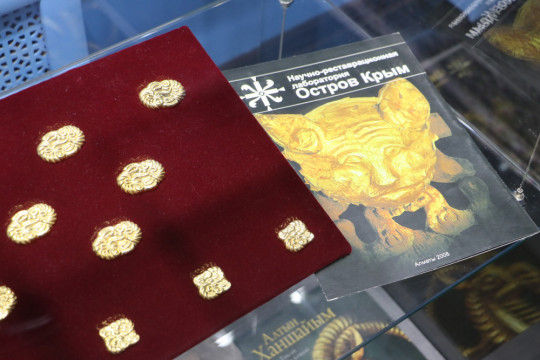
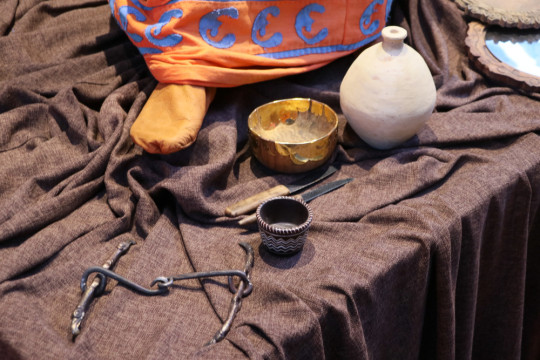

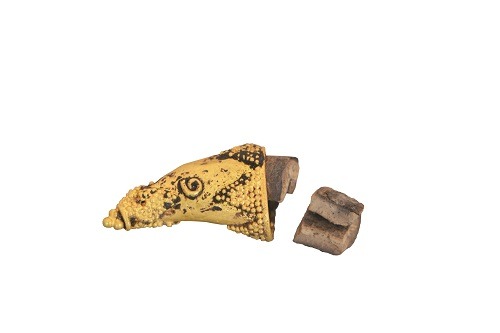
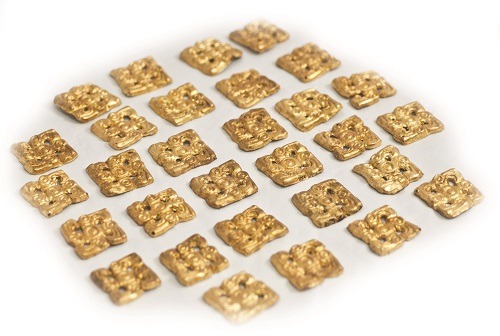
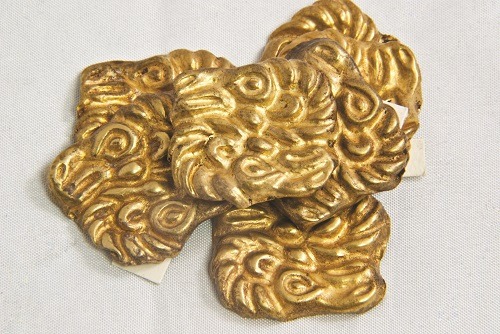
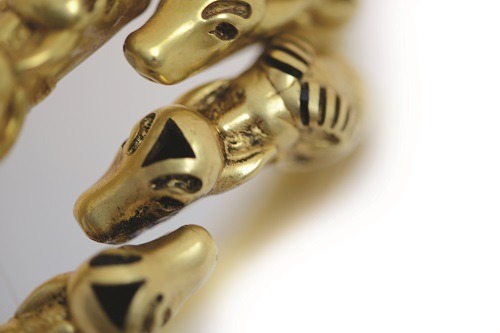
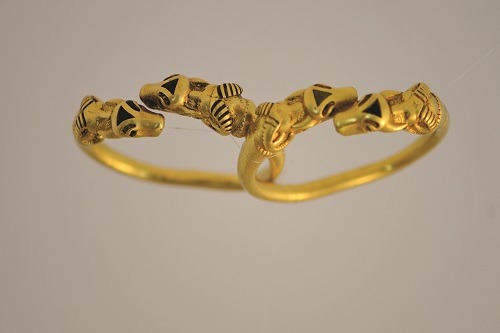
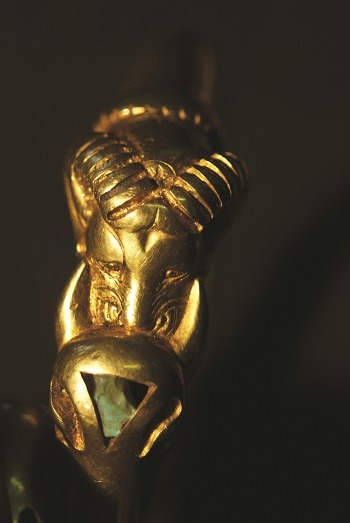
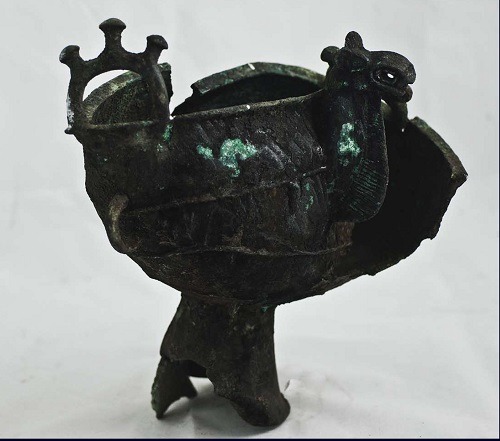
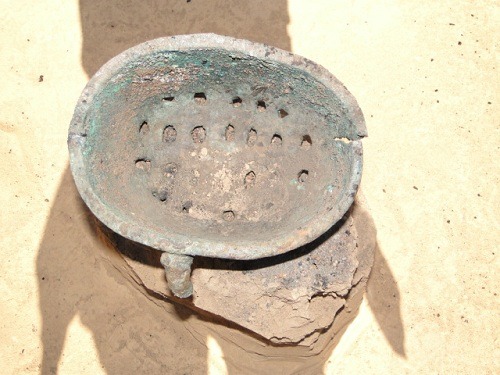
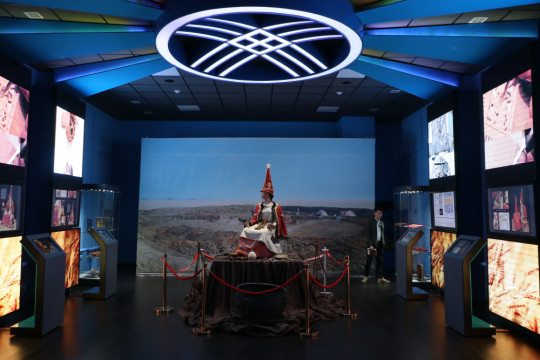
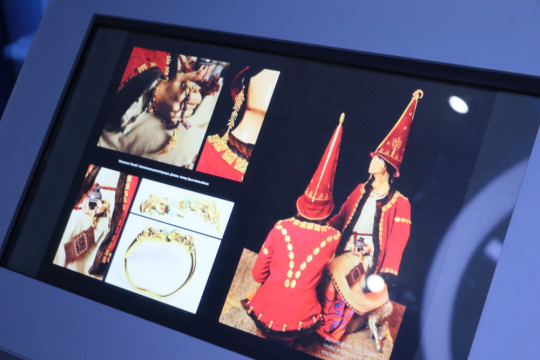
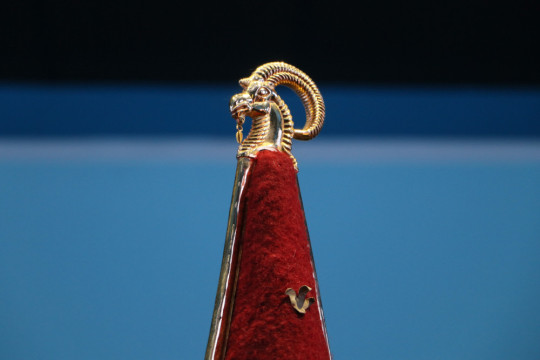

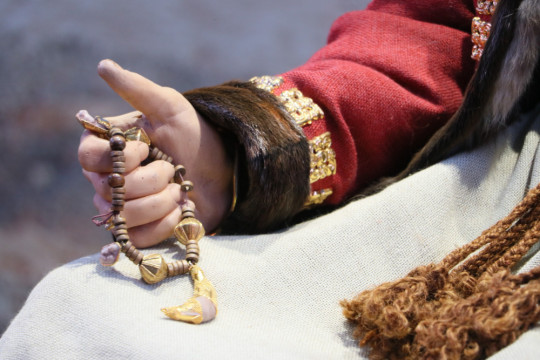
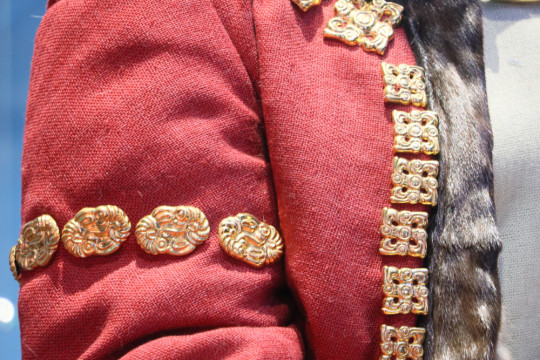
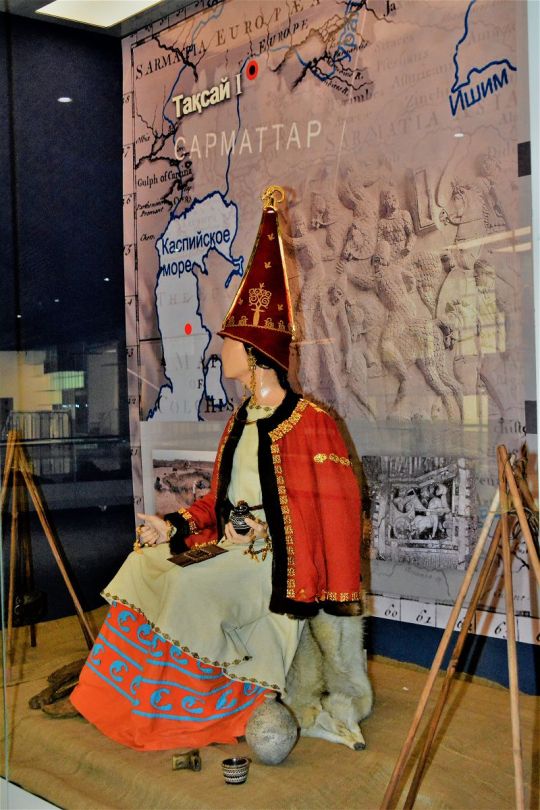
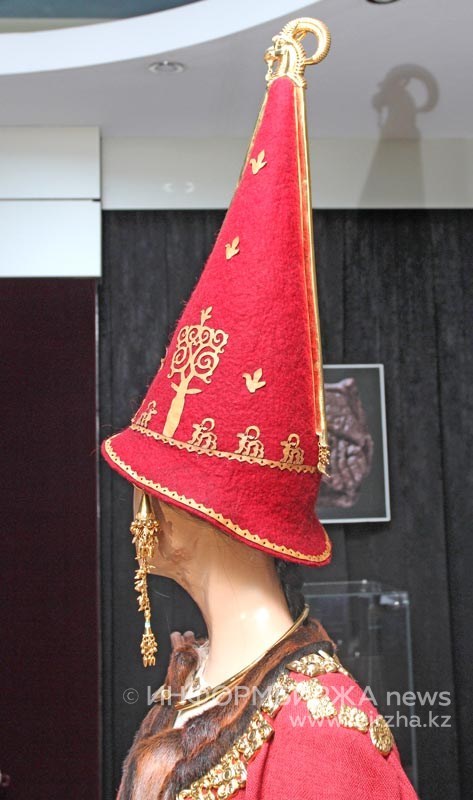
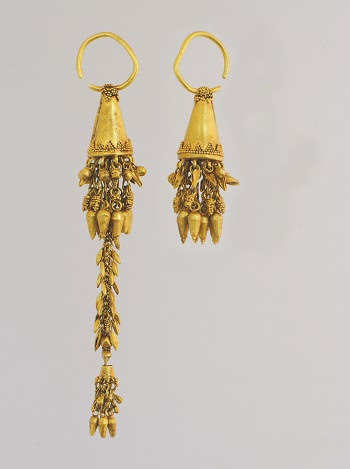
Scythian/Sarmatian 'Golden Princess' of Taksay 1 (Mound 6) Burial Complex 6th-4th C. BCE. Note the abundant swastikas all over her dress. More photos on my blog at link at bottom of this post.
"Western Kazakhstani archaeologists have finally displayed the exclusive artifacts found in the ancient burial discovered in 2012, West Kazakhstan Oblast Center for History and Archaeology.
The ancient burial containing remains of a noble woman was discovered in Terekty district in Western Kazakhstan Oblast two years ago and was declared the oldest "golden" burial on the territory of Kazakhstan.
This is one of the burials in the "golden series", meaning a mound containing golden fragments along with a skeleton. One such mound, discovered in south-eastern Kazakhstan in 1969, had warrior's equipment and assorted funerary goods that included 4,000 golden fragments and was dubbed the Golden Man.
The archeological find made 2 years ago in West Kazakhstan contained the skeleton of a noble woman in the burial mound called Taksay-1. Next to the body there were all sorts of gold and silver vessels, makeup kits, remnants of richly decorated headdress and many pieces of golden jewelry. A horse bridle and household items that were believed to be necessary in the afterlife were also found.
The noble woman was covered with a blanket embroidered with golden plaques and there were more than 500 different golden fragments, which earned the woman her name - the Golden Woman or the Golden Princess.
The artifact of particular importance was a wooden comb depicting a battle scene in the war of the Saks against the Persians.
Prominent scientists and research centers of Japan, Germany and Russia were attracted to the uniqueness of the burial and studied the findings along with their Kazakhstani colleagues.
The latest breakthrough in the work allowed Murat Sdykov, head of West Kazakhstan Oblast Center for History and Archaeology, to identify the age of the burial. “The results of laboratory studies showed that the burial dates back to 4-5 centuries BC,” Sdykov said. The age of the woman was hard to identify due to heavy decomposition of bones. Sdykov informed that two female guards were buried along with the Golden Princess.
“The richness of the burial speaks about the status of the buried woman. It points that there were few rich people in that period and that the society was already stratified. There are two other kurgans [mounds] next to Taksay, which we will excavate next year. It is noteworthy that this mound had not been damaged or looted,” Sdykov said.
The burial mound was made around a wooden structure that sagged a long time ago. At some point tomb robbers attempted to raid the burial but, fortunately, failed to reach the burial chamber itself.
Reconstruction of the garment was entrusted to the famous restorer Krym Altynbekov. Thanks to his work, one can now see what Golden Princess might have looked like 2500 years ago. Gold plaques of four types were sewn on the upper part of the garment: differently shaped geometric pieces depicted ram griffins, rams, griffins and swastikas.
Golden Woman is one of the most astonishing archeological findings of the recent years. It sheds some light on the wealth and power of the ancient Scythians [Saks]. The Saka were a group of nomadic warrior tribes of Iranian origin, who inhabited the steppes of modern-day Kazakhstan in 1 thousand BC to first centuries AD."
-taken from TengriNews
#scythian#scythian gold#swastika#saka#sarmatian#pagan#history#ancient history#antiquities#antiquity#art#artifacts#museums#ancient jewelry#archaeology#6th century bce
23 notes
·
View notes
Text
Saints&Reading: Tuesday, January 16, 2024
janaury 3_january 16
HOLY PROPHET MALACHI (400 B.C.)
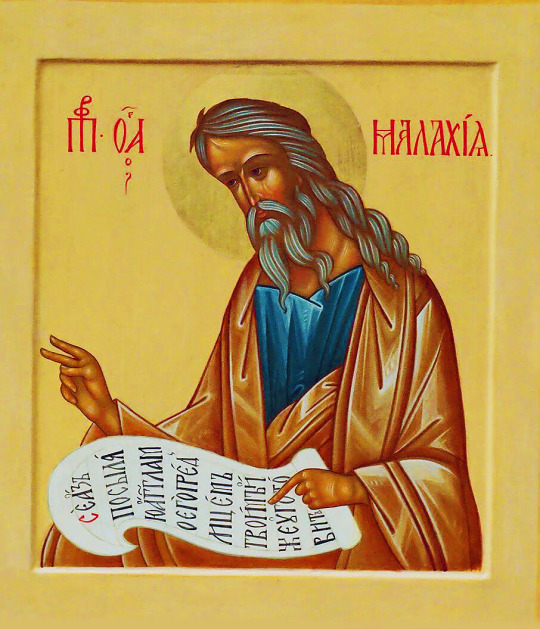
The Holy Prophet Malachi lived 400 years before the Birth of Christ, at the time of the return of the Jews from the Babylonian Captivity. Malachi was the last of the Old Testament prophets, therefore the holy Fathers call him “the seal of the prophets.”
Manifesting himself an image of spiritual goodness and piety, he astounded the nation and was called Malachi, i.e., an angel. His prophetic book is included in the Canon of the Old Testament. In it he upbraids the Jews, foretelling the coming of Jesus Christ and His Forerunner, and also the Last Judgment (Mal 3:1-5; 4:1-6).
VENERABLE EUTHYMIUS (TAQAISHVILI) THE MAN OF GOD OF TBILISI (1953)
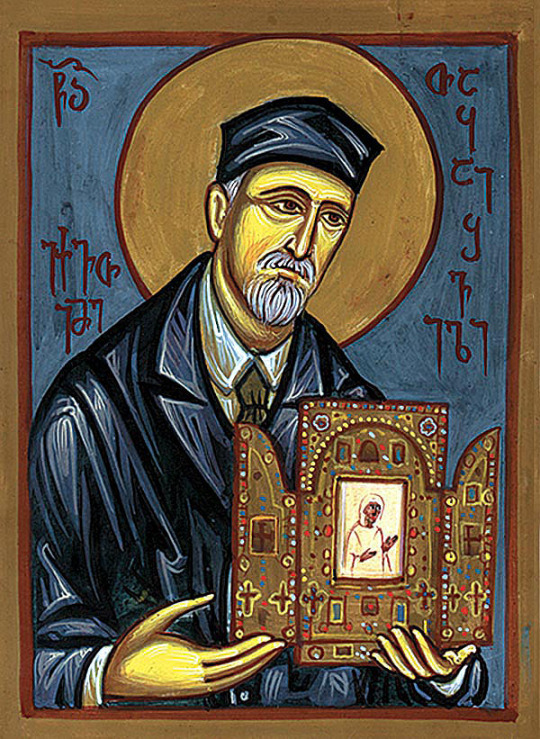
Saint Ekvtime (Euthymius) Taqaishvili, called the “Man of God,” was born January 3, 1863, in the village of Likhauri, in the Ozurgeti district of Guria, to the noble family of Svimeon Taqaishvili and Gituli Nakashidze. He was orphaned at a young age and raised by his uncle.
From early childhood St. Ekvtime demonstrated a great passion for learning. Having completed his studies at the village grammar school, he enrolled at Kutaisi Classical High School. In 1883 he graduated with a silver medal and moved to St. Petersburg to continue his studies in the department of history-philology at St. Petersburg University. In 1887, having successfully completed his studies and earned a degree in history, St. Ekvtime returned to Georgia and began working in the field of academia. His profound faith and love for God and his motherland determined his every step in this demanding and admirable profession.
In 1895 Ekvtime married Nino Poltoratskaya, daughter of the famous Tbilisi attorney Ivan Poltoratsky, who was himself a brother in-law and close friend of St. Ilia Chavchavadze the Righteous. From the very beginning of his career St. Ekvtime began to collect historical-archaeological and ethnographical materials from all over Georgia. His sphere of scholarly interests was broad, including historiography, archaeology, ethnography, epigraphy, numismatics, philology, folklore, linguistics, and art history. Above all, St. Ekvtime strove to learn more about Georgian history and culture by applying the theories and methodologies of these various disciplines to his work.
In 1889 St. Ekvtime established the Exarchate Museum of Georgia, in which were preserved ancient manuscripts, sacred objects, theological books, and copies of many important frescoes that had been removed from ancient churches. This museum played a major role in rediscovering the history of the Georgian Church.
In 1907 St. Ekvtime founded the Society for Georgian History and Ethnography. Of the many expeditions organized by this society, the journey through Muslim (southwestern) Georgia was one of the most meaningful. Having witnessed firsthand the aftermath of the forced isolation and Islamization of this region, St. Ekvtime and his fellow pilgrims acquired a greater love for the Faith of their forefathers and became more firmly established in their national identity. Though they no longer spoke the Georgian language, the residents of this region received the venerable Ekvtime with great respect, having sensed from his greeting and kindness that he had come from their far-off motherland.
There was not a single patriotic, social or cultural movement in Georgia during the first quarter of the 20th century in which St. Ekvtime did not actively take part. Among his other important achievements, he was one of the nine professors who founded Tbilisi University in 1918. St. Ekvtime also vigorously advocated the restoration of the autocephaly of the Georgian Orthodox Church.
On March 11, 1921, the Georgian government went into exile in France. The government archives and the nation’s spiritual and cultural treasures were also flown to France for protection from the Bolshevik danger. St. Ekvtime was personally entrusted to keep the treasures safe, and he and his wife accompanied them on their flight to France. St. Ekvtime bore the hardships of an emigrant’s life and the horrors of World War II with heroism, while boldly resisting the onslaught of European and American scholars and collectors and the claims of other Georgian emigrants to their “family relics.”
In 1931 St. Ekvtime’s wife, Nino, his faithful friend and companion, died of starvation. The elderly widower himself often drew near to the brink of death from hunger, cold, and stress, but he never faltered in his duty before God and his motherland—he faithfully protected his nation’s treasures.
The perils were great for St. Ekvtime and the treasures he protected: British and American museums sought to purchase the Georgian national artifacts; a certain Salome Dadiani, the widow of Count Okholevsky, declared herself the sole heir of the Georgian national treasure; during World War II the Nazis searched St. Ekvtime’s apartment; even the French government claimed ownership of the Georgian treasures.
Finally, the Soviet victory over fascist Germany created conditions favorable for the return of the national treasures to Georgia. According to an agreement between Stalin and De Gaulle, the treasures and their faithful protector were loaded onto an American warplane and flown back to their motherland on April 11, 1945. When he finally stepped off the plane and set foot on Georgian soil, St. Ekvtime bowed deeply and kissed the earth where he stood. Georgia greeted its long-lost son with great honor. The people overwhelmed St. Ekvtime with attention and care, restored his university professorship, and recognized him as an active member of the Academy of Sciences. They healed the wounds that had been inflicted on his heart.

Exhausted by the separation from his motherland and the woes of emigration, St. Ekvtime rejoined society with the last of his strength. But mankind’s enemy became envious of the victory of good over evil and rose up against St. Ekvtime’s unshakable spirit. In 1951 the Chekists arrested his stepdaughter, Lydia Poltoratskaya. St. Ekvtime, who by that time was seriously ill, was now left without his caregiver. In 1952, without any reasonable explanation, St. Ekvtime was forbidden to lecture at the university he himself had helped to found, and he was secretly placed under house arrest. The people who had reverently greeted him upon his return now trembled in fear of his persecution and imminent death. Many tried to visit and support St. Ekvtime, but they were forbidden. On February 21, 1953, St. Ekvtime died of a heart attack, and three days later a group of approximately forty mourners accompanied the virtuous prince to his eternal resting place.
On February 10, 1963, the centennial of St. Ekvtime’s birth, his body was reburied at the Didube Pantheon in Tbilisi. When his grave was uncovered, it was revealed that not only his body, but even his clothing and footwear had remained incorrupt. St. Ekvtime’s relics were moved once again, to the Pantheon at the Church of St. Davit of Gareji on Mtatsminda, where they remain today.
The body of Nino Poltoratskaya-Taqaishvili was brought from Leville (France) and buried next to St. Ekvtime on February 22, 1987.
The Holy Synod of the Georgian Apostolic Orthodox Church canonized St. Ekvtime on October 17, 2002, and joyously proclaimed him a “Man of God.”
© 2006 St. Herman of Alaska Brotherhood
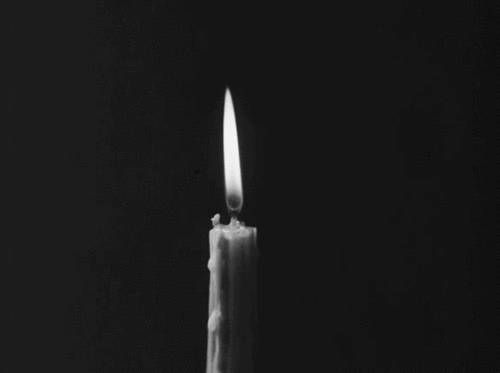
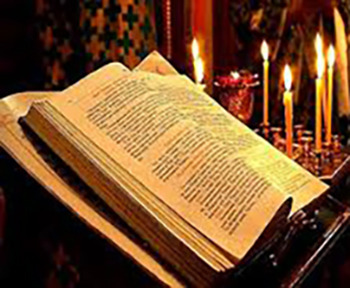
1 PETER 3:10-22
10 For "He who would love life And see good days, Let him refrain his tongue from evil, And his lips from speaking deceit. 11 Let him turn away from evil and do good; Let him seek peace and pursue it. 12 For the eyes of the LORD are on the righteous, And His ears are open to their prayers; But the face of the LORD is against those who do evil." 13 And who is he who will harm you if you become followers of what is good? 14 But even if you should suffer for righteousness' sake, you are blessed. "And do not be afraid of their threats, nor be troubled." 15 But sanctify the Lord God in your hearts, and always be ready to give a defense to everyone who asks you a reason for the hope that is in you, with meekness and fear; 16 having a good conscience, that when they defame you as evildoers, those who revile your good conduct in Christ may be ashamed. 17 For it is better, if it is the will of God, to suffer for doing good than for doing evil. 18 For Christ also suffered once for sins, the just for the unjust, that He might bring us to God, being put to death in the flesh but made alive by the Spirit, 19 by whom also He went and preached to the spirits in prison, 20 who formerly were disobedient, when once the Divine longsuffering waited in the days of Noah, while the ark was being prepared, in which a few, that is, eight souls, were saved through water. 21 There is also an antitype which now saves us-baptism (not the removal of the filth of the flesh, but the answer of a good conscience toward God), through the resurrection of Jesus Christ, 22 who has gone into heaven and is at the right hand of God, angels and authorities and powers having been made subject to Him.
MATTHEW 10:16-22
16 Behold, I send you out as sheep in the midst of wolves. Therefore be wise as serpents and harmless as doves. 17 But beware of men, for they will deliver you up to councils and scourge you in their synagogues. 18 You will be brought before governors and kings for My sake, as a testimony to them and to the Gentiles. 19 But when they deliver you up, do not worry about how or what you should speak. For it will be given to you in that hour what you should speak; 20 for it is not you who speak, but the Spirit of your Father who speaks in you. 21 Now brother will deliver up brother to death, and a father his child; and children will rise up against parents and cause them to be put to death. 22 And you will be hated by all for My name's sake. But he who endures to the end will be saved.
#orthodoxy#orthodoxchristianity#easternorthodoxchurch#originofchristianity#spirituality#holyscriptures#gospel#bible#wisdom#saints
2 notes
·
View notes
Text
Character Intro: Litismós (Kingdom of Ichor)

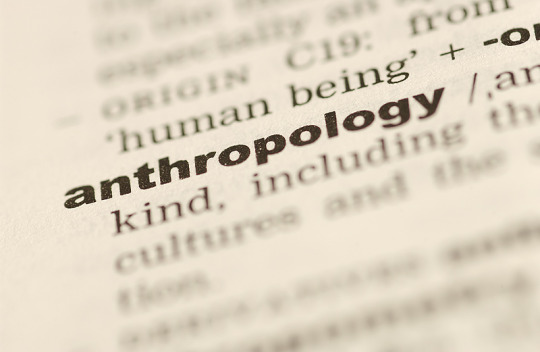











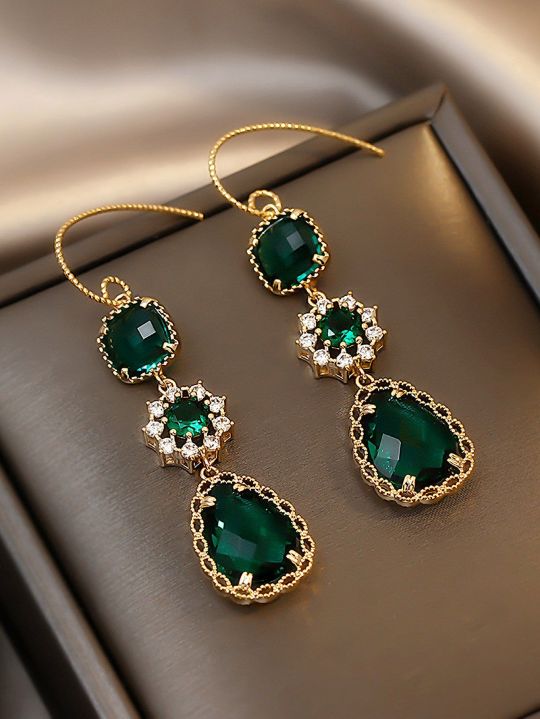



Age- 38 (immortal)
Location- Skyline district, New Olympus
Personality- Poised & refined, she has a great love and respect for art, music, literature, and fashion. She does have a tendency to be a bit snobby for her own personal opinions & taste for the finer things in life, but she's an active conversationalist. She's recently married.
She has the standard abilities of a goddess except shapeshifting. Her other powers/abilities include having an eidetic memory, anthropology mastery (anthroscience; as well as many other applications like detail intuition, history intuition, archaeology mastery, etc...), and culture manipulation (social behavior & norms found in societies as well as the knowledge, beliefs, arts, laws, customs, cuisine, capabilities, & habits of individuals).
She's responsible for maintaining the cultural integrity of Olympius.
A true polyglot, she's fluent in several languages including Latin, French, Minoan, Tsakonian, and Cypriot. She can write in Old Greek as well!
Litismós' main abode is with her husband Isorropía (Isorro) (god of duality, balance, & equilibrium) at The Áltios Building, a luxury apartment building in the Skyline neighborhood of New Olympus. They're also currently overseeing the construction of their mansion in the state of Athens. The apartment has four bedrooms, 2 1/2 bathrooms, a HUGE walk-in closet, and a stainless steel kitchen. The interior design is very elegant, sophisticated, & chic. Paintings and sculptures are decorated throughout. Litismós & her husband both have dragons- hers is a she-dragon named Xymeria who has shimmering silver & dark teal scales and pearl white horns, claws, & crests. The dragon saddle is made from the finest leather!
A go-to drink for her is espresso. She uses her espresso machine in the kitchen almost everyday. She also likes cosmopolitans, gin & tonics, classic martins, bellinis, mimosas, champagne, pinot noir, golden cadillacs, pinot gris, whiskey sours, peppermint tea, and vieux carré cocktails. Her usual from The Roasted Bean is a large iced green tea.
Litismós and her now husband were together for ten years before they got engaged. She wasn't intimidated or fearful about his general standoffish attitude or bipolar disorder (especially his manic episodes). She fell in love with his vulnerability & intelligence. She loves how comfortable she feels around him and how he stares at her like she's a million drachmas even if she's in a plain silk T-shirt & leggings with her hair in a messy bun. The wedding took place at The Parthenon (after Litismós got clearance from the wisdom goddess). It was a high class and sophisticated affair with most of the pantheon in attendance. The bride wore a Luxuria wedding gown- a strapless ball gown with a sweetheart neckline made from organza & silk mikado. The wow factor was the crystal stones and sparkling sequins! At the reception, there was a white chocolate fountain & hors d'ouevres like proscuitto wrapped figs drizzled in pomegrante molasses and spicy lamb meatballs with a green herb olive oil dip. The wedding was covered in Modern Olympus magazine.
She likes when her husband makes his specialty mofongo for breakfast. She also likes warm buttery croissants (with caviar butter), the egg white breakfast burrito (loaded with mushrooms, black olives, & peppers) from The Bread Box, or a bowl of rizogalo (topped with poached pear slices).
She prefers her star on the Pantheon Walk of Fame than having a temple built in her honor.
A guilty pleasure for her are oysters topped with beurre blanc. She also likes spicy tuna nigiri.
Litismós' main career is teaching anthropology at New Olympus University. There are six primary courses and she has a very thorough approach to teaching with an open space for dialogue amongst her & the students. For other means of income she also writes for The Oracle newspaper, Modern Olympus, and O Dianooumenos. She also models for/endorses Megaleio, ýfasma óneiro, Euryphaessa, Diamond Ave., & Luxuria. For her own personal endeavors, Litismós has been thinking about releasing a parfum and developing an idea for a new TV program- a hidden camera social experiment show!
Her article in Modern Olympius titled "Megaleio & Diamond Ave.: More Than Just a Bag" recieved critical attention.
She has twenty pairs of shoes from Diamond Ave. with the diamond encrusted soles!
She's a frequent customer at The Luxe, a high end luxurious treatery. Her favorite things to get there are the champagne truffles (which are dusted with edible gold) & a pound of champagne gummy bears!
In the pantheon Litismós has gotten to know her brother-in-law Psionikós (god of the mind). She's also friends with Kéfi (goddess of mirth); her future sister-in-law, Rhapso (goddess of sewing), Favian (god of philosophy), Argía (goddess of holidays), Eikono (goddes of iconography & literature), Agathodaemon (Daemon) (god of vineyards, grainfields, & luck), Evimería (goddess of prosperity), Aígli (goddess of glamour), Lyrikós (Titaness of voice & song), Neicus (god of debate & appeal), Ogygia (one of The Nesoi), Amphictyonis (Amy) (goddess of diplomacy), Momus (god of mockery, satire, & ridicule), Theia (Titaness of sight & heavenly light), Clymene (Titaness of fame & renown), Praxidike (goddess of judicial punishment), Mnemosyne (Titaness of memory & language), and Orthosia (goddess of wealth). She has a friendly rapport with most of the other deities.
Litismós has her own glamour doll collectible!
She oversees the latern festival that takes place every year at Eaglepoint Park.
Litismós unknowingly went on Aisa's (goddess of lot & fate) war path after she bid on a cocktail ring that Aisa wanted- an 18K rose gold three stone ring (blue topaz, diamond, and blue sapphire). Litismós got it for 15,000 drachmas.
Her & Argía went to Athens one time for the state's annual olive festival.
She prefers vinyl records to CDs and music downloads.
Her favorite frozen treat is coconut champagne ice cream!
She along with Ogygia and Mnemosyne went to Athens where they saw a dance troupe perform a kalamatianos dance, a traditonal dance popular amongst the Old Order community (folks that live in the way of ancient times). Litismós was introduced to Apheleia (goddess of simplicity) there.
In her free time she enjoys frequenting the opera, ballet, museums, art galleries, & theater. She also likes swimming, ballroom dancing, listening to classical music, painting (a few of her works have been shown at NOMMA), shopping, horseback riding, reading, sewing, and writing.
Her all time favorite meal is garlic crusted salmon with caviar & creme fraiche. She also likes her husband's pernil.
"Culture is a way of coping with the world by defining it in detail."
#my oc#original character#my original oc#oc character#my character#my oc character#oc intro#character intro#oc introduction#character introduction#modern greek gods#modern greek mythology#greek myth retellings#greek goddess#greek goddesses
2 notes
·
View notes
Note
Dating sim for Ariete!

Name: Ariete Qurioe
Their Profession: Owner of Qurioe’s Quriosities Museum
Where they can be found: Running her museum, checking out antique stores or auction houses for rare goods, hiking in the regions her hive is situated in (Alternian equivalent to the Lakes District, England), exploring old castle ruins
Favourite food type: She’s not picky, but she prefers eating consistent larger meals throughout the night over constant snacking. She tends to like heartier soups and stews, as well as your classic pub food like pies
Favourite alcoholic drink: She’s not big on alcohol, but I can see her liking sherry or some other fortified wine
Favourite trait: Tolerance. She knows she can be a bit of a handful and say the wrong things a lot, so she’d want her partner to know that she is trying to not actively piss them off lmao. She’s also not that great at judging how close she is with someone and tends to make jokes that are appropriate for good friends but not so much for strangers
Where they would go on a date: She’d love to take someone on one of her ‘archaeological trips’ (read: digging up castle ruins looking for buried antiques), but a nature walk is also fine too. She’d also really like going somewhere fancy, so she gets to feel like she’s a part of high society
Ideal gift: Something to display in her museum. Just make sure it’s a genuine antique, she’s got a really good eye for figuring out the eras something has been made and can’t stand faux-vintage objects. Otherwise, she loves collecting hats and likes jewellery as well
3 notes
·
View notes
Text
Traveling exhibition Nhe’ẽ Porã: Memory and Transformation – Belém (PA)
Emílio Goeldi Paraense Museum
From February 7th to July 28th, 2024
It proposes a dive into the history, memory and current reality of the languages of the indigenous peoples of Brazil, through ethnographic and archaeological objects, audiovisual installations and works of art. The exhibition seeks to show other points of view on the material and immaterial territories, histories, memories and identities of these people, bringing to light their trajectories of struggle and resistance, as well as the corners and charms of their cultures.
Among the pieces included in the exhibition are several buttons – a type of adornment used to enlarge the lower lip; and tembetás - pieces of quartz placed under the lips. Both are objects that demonstrate skills valued among many people: oratory and listening. Also included in the exhibition was a rare bench carved in quartz, which in the Tukano worldview is directly associated with the grandmother of the universe, Yepário.
For a century and a half, the Museu Paraense Emílio Goeldi has been carrying out research, dissemination and preservation work on the ways of indigenous peoples, among the most recent includes the project Replicando o Passado, in partnership with potters from Icoaraci, district of Belém (PA ).
A product of this project, a replica of a Marajoara funerary urn, originally created by indigenous people who inhabited the Amazon region since approximately the year 500, will also be displayed at the exhibition.
Find out more about the exhibition
“Language is thought, language is spirit, language is a way of seeing the world and appreciating life”. This is how curator Daiara Tukano describes the starting point of Nhe’ẽ Porã: Memory and Transformation. The immersion begins with the name of the exhibition itself, which comes from the Guarani Mbya language: nhe’ẽ means spirit, breath, life, word, speech; and porã means beautiful, good. Together, the two words mean “beautiful words”, “good words” – that is, sacred words that give life to the human experience on earth.
With the participation of around 50 indigenous professionals, the exhibition is co-curated by anthropologist Majoí Gongora; special consultancy from Luciana Storto, a linguist specializing in the study of indigenous languages; in dialogue with the special curator of the Portuguese Language Museum, Isa Grinspum Ferraz.
The exhibition has a circular logic guided by a river of words written in different indigenous languages that crosses the entire exhibition space, connecting the rooms in a continuous cycle. At the beginning of the exhibition, the visitor comes across a forest of indigenous languages representing the great diversity that exists today in Brazil. In this forest, the public will be able to discover the sound of several of them.
The room next door, “Language is Memory”, brings to light histories of contact, violence and conflict resulting from the invasion of indigenous territories from the 16th century to contemporary times, problematizing the colonial process that declares itself “civilizing”. In this environment, other stories will be told through archaeological objects, works by indigenous artists, documentary records, audiovisual resources, multimedia and maps created especially for the exhibition with data on the distribution of the population and indigenous languages across Brazilian territory.
The transformations of indigenous languages are addressed in content that explores the resilience, richness and multiplicity of indigenous peoples' forms of expression. “We put into debate the fact that we are described as unscripted people, without writing, but our paintings are also written – just not alphabetic”, explains Daiara Tukano.
In the third room, the public will learn about the plurality of contemporary indigenous actions and creations, distributed in thematic niches, based on their protagonism in different spaces of society, such as their performance in teaching, research and artistic languages. In the space it is also possible to watch scenes from the Indigenous Peoples March, directed by filmmaker Kamikia Kisédjê.
By following the river's route, visitors reach a fourth nocturnal environment, an introspective dreamlike atmosphere that allows contact with the force present in the songs of masters of beautiful words. The river that ran along the exhibition floor now climbs the wall like a large snake until it turns into clouds of words – preparing the rain that will flow over the river itself again, continuing the cycle.
source: https://www.gov.br/museugoeldi/pt-br/arquivos/noticias/exposicao-nhe2019e-pora-memoria-e-transformacao-chega-ao-museu-goeldi
#edisonmariotti edison mariotti @edisonblog
.br
Exposição itinerante Nhe’ẽ Porã: Memória e Transformação – Belém (PA)
Museu Paraense Emílio Goeldi
De 7 de fevereiro a 28 de julho de 2024
Propõe um mergulho na história, memória e realidade atual das línguas dos povos indígenas do Brasil, através de objetos etnográficos, arqueológicos, instalações audiovisuais e obras de arte. A exposição busca mostrar outros pontos de vista sobre os territórios materiais e imateriais, histórias, memórias e identidades desses povos, trazendo à tona suas trajetórias de luta e resistência, assim como os cantos e encantos de suas culturas.
Entre as peças incorporadas à exposição estão vários botoques – tipo de adorno usado para alargar o lábio inferior; e tembetás - peças de quartzo colocadas sob os lábios. Ambos são objetos que evidenciam habilidades valorizadas entre muitos povos: a oratória e a escuta. Também foi incluído na exposição um raro banco esculpido em quartzo que na cosmovisão tukano está diretamente associado à avó do universo, Yepário.
Há um século e meio que o Museu Paraense Emílio Goeldi desenvolve trabalhos de pesquisa, divulgação e preservação dos modos de fazer dos povos indígenas, dentre os mais recentes inclui o projeto Replicando o Passado, em parceria com ceramistas de Icoaraci, distrito de Belém (PA).
Produto deste projeto, também será exibida na exposição a réplica de uma urna funerária marajoara, elaborada originalmente por indígenas que habitaram a região amazônica desde aproximadamente o ano 500.
Saiba mais sobre a exposição
“Língua é pensamento, língua é espírito, língua é uma forma de ver o mundo e apreciar a vida”. É assim que a curadora Daiara Tukano descreve o ponto de partida de Nhe’ẽ Porã: Memória e Transformação. A imersão começa no próprio nome da mostra, que vem da língua Guarani Mbya: nhe’ẽ significa espírito, sopro, vida, palavra, fala; e porã quer dizer belo, bom. Juntos, os dois vocábulos significam “belas palavras”, “boas palavras” – ou seja, palavras sagradas que dão vida à experiência humana na terra.
Contando com a participação de cerca de 50 profissionais indígenas, a exposição tem co-curadoria da antropóloga Majoí Gongora; consultoria especial de Luciana Storto, linguista especialista no estudo de línguas indígenas; em diálogo com a curadora especial do Museu da Língua Portuguesa, Isa Grinspum Ferraz.
A exposição tem uma lógica circular guiada por um rio de palavras grafadas em diversas línguas indígenas que atravessa todo o espaço expositivo, conectando as salas em um ciclo contínuo. No início da exposição, o visitante se depara com uma floresta de línguas indígenas representando a grande diversidade existente hoje no Brasil. Nessa floresta, o público poderá conhecer a sonoridade de várias delas.
A sala ao lado, “Língua é Memória”, traz à tona históricos de contato, violência e conflito decorrentes da invasão dos territórios indígenas desde o século 16 até a contemporaneidade, problematizando o processo colonial que se autodeclara “civilizatório”. Neste ambiente, outras histórias serão contadas por meio de objetos arqueológicos, obras de artistas indígenas, registros documentais, recursos audiovisuais, multimídia e mapas criados especialmente para a exposição com dados sobre a distribuição da população e das línguas indígenas pelo território brasileiro.
As transformações das línguas indígenas são tratadas em conteúdos que exploram a resiliência, a riqueza e a multiplicidade das formas de expressão dos povos indígenas. “Colocamos em debate o fato de que somos descritos como povos ágrafos, sem escrita, mas nossas pinturas também são escritas – só que não alfabéticas”, explica Daiara Tukano.
Na terceira sala, o público conhecerá a pluralidade das ações e criações indígenas contemporâneas, distribuídas em nichos temáticos, a partir de seu protagonismo em diferentes espaços da sociedade, a exemplo de sua atuação no ensino, na pesquisa e nas linguagens artísticas. No espaço é possível ainda assistir a cenas da Marcha dos Povos Indígenas, sob direção do cineasta Kamikia Kisédjê.
Ao acompanhar o percurso do rio, os visitantes alcançam um quarto ambiente, noturno, uma atmosfera onírica introspectiva que permite o contato com a força presente nos cantos de mestres e mestras das belas palavras. O rio que percorria o chão da exposição, agora sobe a parede como uma grande cobra até se transformar em nuvens de palavras – preparando a chuva que voltará a correr sobre o próprio rio, dando continuidade ao ciclo.
Traveling exhibition Nhe’ẽ Porã: Memory and Transformation – Belém (PA) Emílio Goeldi Paraense Museum From February 7th to July 28th, 2024 It proposes a dive into the history, memory and current reality of the languages of the indigenous peoples of Brazil, through ethnographic and archaeological objects, audiovisual installations and works of art.
The exhibition seeks to show other points of view on the material and immaterial territories, histories, memories and identities of these people, bringing to light their trajectories of struggle and resistance, as well as the corners and charms of their cultures.
Among the pieces included in the exhibition are several buttons – a type of adornment used to enlarge the lower lip; and tembetás - pieces of quartz placed under the lips. Both are objects that demonstrate skills valued among many people: oratory and listening.
Also included in the exhibition was a rare bench carved in quartz, which in the Tukano worldview is directly associated with the grandmother of the universe, Yepário.
For a century and a half, the Museu Paraense Emílio Goeldi has been carrying out research, dissemination and preservation work on the ways of indigenous peoples, among the most recent includes the project Replicando o Passado, in partnership with potters from Icoaraci, district of Belém (PA ).
A product of this project, a replica of a Marajoara funerary urn, originally created by indigenous people who inhabited the Amazon region since approximately the year 500, will also be displayed at the exhibition.
Find out more about the exhibition “Language is thought, language is spirit, language is a way of seeing the world and appreciating life”. This is how curator Daiara Tukano describes the starting point of Nhe’ẽ Porã: Memory and Transformation.
The immersion begins with the name of the exhibition itself, which comes from the Guarani Mbya language: nhe’ẽ means spirit, breath, life, word, speech; and porã means beautiful, good. Together, the two words mean “beautiful words”, “good words” – that is, sacred words that give life to the human experience on earth.
With the participation of around 50 indigenous professionals, the exhibition is co-curated by anthropologist Majoí Gongora; special consultancy from Luciana Storto, a linguist specializing in the study of indigenous languages; in dialogue with the special curator of the Portuguese Language Museum, Isa Grinspum Ferraz. The exhibition has a circular logic guided by a river of words written in different indigenous languages that crosses the entire exhibition space, connecting the rooms in a continuous cycle.
At the beginning of the exhibition, the visitor comes across a forest of indigenous languages representing the great diversity that exists today in Brazil. In this forest, the public will be able to discover the sound of several of them.
The room next door, “Language is Memory”, brings to light histories of contact, violence and conflict resulting from the invasion of indigenous territories from the 16th century to contemporary times, problematizing the colonial process that declares itself “civilizing”.
In this environment, other stories will be told through archaeological objects, works by indigenous artists, documentary records, audiovisual resources, multimedia and maps created especially for the exhibition with data on the distribution of the population and indigenous languages across Brazilian territory.
The transformations of indigenous languages are addressed in content that explores the resilience, richness and multiplicity of indigenous peoples' forms of expression.
“We put into debate the fact that we are described as unscripted people, without writing, but our paintings are also written – just not alphabetic”, explains Daiara Tukano. In the third room, the public will learn about the plurality of contemporary indigenous actions and creations, distributed in thematic niches, based on their protagonism in different spaces of society, such as their performance in teaching, research and artistic languages.
In the space it is also possible to watch scenes from the Indigenous Peoples March, directed by filmmaker Kamikia Kisédjê. By following the river's route, visitors reach a fourth nocturnal environment, an introspective dreamlike atmosphere that allows contact with the force present in the songs of masters of beautiful words.
The river that ran along the exhibition floor now climbs the wall like a large snake until it turns into clouds of words – preparing the rain that will flow over the river itself again, continuing the cycle.

0 notes
Text
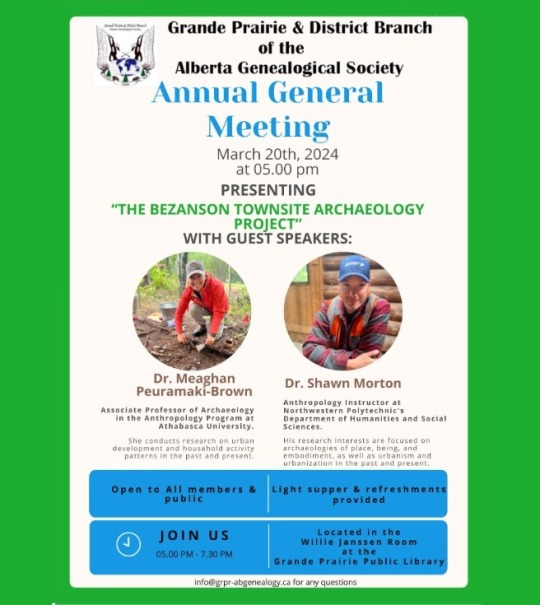
The Grande Prairie & District Branch of the Alberta Genealogical Society’s AGM is March 20th at 5 pm in the Willie Jansen Room at the Library. This event is open to all Members and the public and features a presentation on the Bezanson Townsite Archaeology project. Email [email protected] for more information.
0 notes
Photo

Extensive Archaeological Endeavors
Early Excavations and Discoveries
In 1960, exploration of Turnovo’s historical sites commenced, focusing on the south transverse fortress wall and the Patriarchal complex. Subsequent years saw significant revelations, with 1963 marking the discovery of a small church in the square in front of the Palace and the excavation of a residential district on the west slope of the hill “Momina Krepost.”
Expansion of Excavations
The scope of archaeological endeavors expanded notably after 1966, following a government decree aimed at developing Turnovo as a historical, cultural, and tourist destination. Spearheaded by a Public Committee and involving a collaboration between archaeologists, the Bulgarian Academy of Sciences, and the Archaeological Museum in Turnovo, the project gained momentum.
Focus Areas and Findings
The archaeological focus centered on key sites such as the central capital fortress, the monastery “Velikata Lavra,” and the church “Sveti Dimitur.” Detailed examinations were conducted on Tsarevets Hill, unraveling the architectural complexities of the north and west fortress walls Private Tours Istanbul, along with associated defenses, gates, towers, and dwellings. Particularly significant was the exploration of the Castle of Bulgarian Tzars and the Patriarchate, shedding light on both secular and clerical powers during The Second Bulgarian Kingdom.
Rich Discoveries
The extensive excavations yielded remarkable findings, including over 500 dwellings, 23 Middle Age churches, and a plethora of artifacts. These discoveries provided valuable insights not only into architectural styles but also into the craft industry, lifestyle, and cultural practices of the society during that era.
Unveiling Historical Layers
A crucial aspect of the excavation involved deciphering the stratification of Turnovo’s history, spanning from the Thracian settlement through the early Byzantium town and the early Middle Age settlement, up to the emergence of the capital Turnovo town. Additionally, the fate of the monuments under the rule of the Ottoman Empire was meticulously examined, enriching our understanding of Turnovo’s complex historical narrative.
0 notes
Text

4,000-Year-Old Ceramic Drainage System Discovered in China
The people of Pingliangtai built and operated the system without any help from a central state government.
China’s Longshan period which lasted from about 2600 to 2000 BCE is best known for its sophisticated pottery shapes, but their sophisticated plumbing is getting some well-deserved attention. A team of archaeologists found the oldest known ceramic water pipes in China, demonstrating that locals were capable of major feats of engineering without a centralized state government. The findings are described in a study published August 14 in the journal Nature Water.
The newly unearthed network of ceramic water pipes and drainage ditches were found at the ancient walled city of Pingliangtai, located in what is now the Huaiyang District of Zhoukou City in central China. The town was home to roughly 500 people during neolithic times and had protective walls and a surrounding moat. It sits on the Upper Huai River Plain on the vast Huanghuaihai Plain, and the climate 4,000 years ago saw large seasonal climate shifts. Summer monsoons could dump a foot and a half of rain on the region every month.

With all this rain, it was critical for the region to manage floodwaters. The people of Pingliangtai appear to have built and operated a two-tier drainage system to help mitigate the rainy season’s excessive rainfall. Simple but coordinated lines of drainage ditches ran parallel to the rows of houses to divert water from the residential area to a series of ceramic water pipes that carried the water into the surrounding moat, and away from the village.
The team says that this network of pipes shows that the community cooperated with one another to build and maintain this drainage system.
“The discovery of this ceramic water pipe network is remarkable because the people of Pingliangtai were able to build and maintain this advanced water management system with stone age tools and without the organization of a central power structure,” study co-author and University College London archaeologist Yijie Zhuang said in a statement. “This system would have required a significant level of community-wide planning and coordination, and it was all done communally.”
The network is made of interconnecting individual segments which run along roads and walls that divert rainwater. According to the team, it shows an advanced level of central planning and is the oldest complete system discovered in China to date.
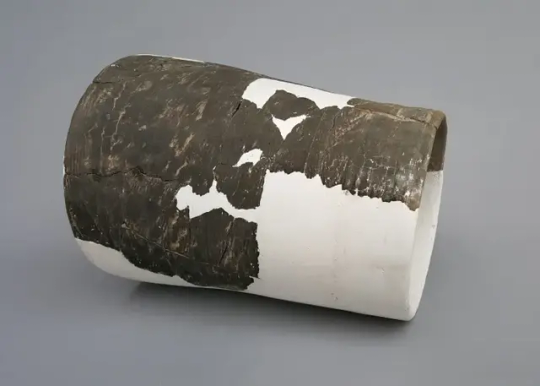

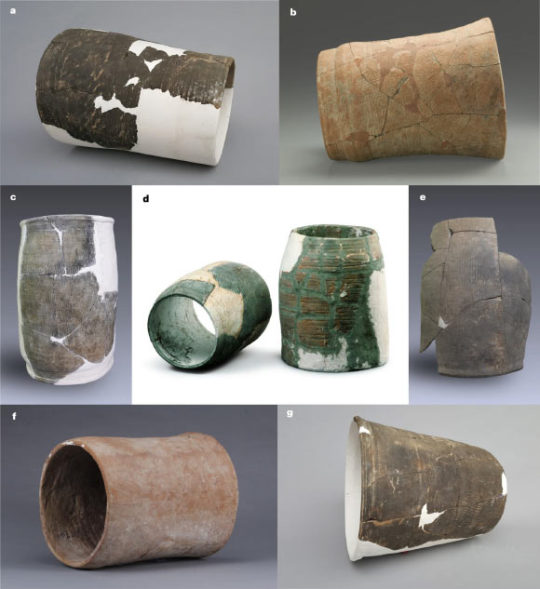
The team was also surprised by this find because the Pingliangtai settlement shows little evidence of a social hierarchy. The homes within it were uniformly small and there aren’t any signs of social stratification or significant inequality amongst the population. Digs at the town’s cemetery also didn’t reveal any evidence of a social hierarchy in burials the way excavations at other nearby towns have.
The level of complexity that these pipes demonstrate also undermines some earlier understanding of archaeological finds that believe only a centralized state power could organize and provide the resources for such a complex water management system. Other ancient societies that used advanced water systems tended to have a stronger, more centralized government, but Pingliangtai shows that that centralized power was possibly not always needed.
“Pingliangtai is an extraordinary site. The network of water pipes shows an advanced understanding of engineering and hydrology that was previously only thought possible in more hierarchical societies,” study co-author and Peking University archaeologist Hai Zhang said in a statement.
The ceramic water pipes also show an advanced level of technology for this period in time. Like with Longshan pottery, there was some variety of decoration and styles, but each pipe segment was about 7.8 and 11.8 inches in diameter and about 11.8 to 15.7 inches long. Multiple segments were slotted into one another to transport the water over long distances.
According to the study, the team can’t say specifically how the labor to build this infrastructure was organized and divided. A similar level of communal coordination would also have been necessary to build the earthen walls and moat that surround Pingliangtai.
By Laura Baisas.

#4000-Year-Old Ceramic Drainage System Discovered in China#ancient city of Pingliangtai#Zhoukou City#ancient artifacts#archeology#archeolgst#history#history news#ancient history#ancient culture#ancient civilizations#ancient china#chinese history
35 notes
·
View notes
Photo
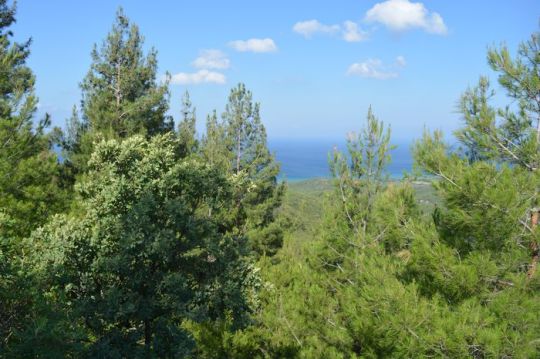
Extensive Archaeological Endeavors
Early Excavations and Discoveries
In 1960, exploration of Turnovo’s historical sites commenced, focusing on the south transverse fortress wall and the Patriarchal complex. Subsequent years saw significant revelations, with 1963 marking the discovery of a small church in the square in front of the Palace and the excavation of a residential district on the west slope of the hill “Momina Krepost.”
Expansion of Excavations
The scope of archaeological endeavors expanded notably after 1966, following a government decree aimed at developing Turnovo as a historical, cultural, and tourist destination. Spearheaded by a Public Committee and involving a collaboration between archaeologists, the Bulgarian Academy of Sciences, and the Archaeological Museum in Turnovo, the project gained momentum.
Focus Areas and Findings
The archaeological focus centered on key sites such as the central capital fortress, the monastery “Velikata Lavra,” and the church “Sveti Dimitur.” Detailed examinations were conducted on Tsarevets Hill, unraveling the architectural complexities of the north and west fortress walls Private Tours Istanbul, along with associated defenses, gates, towers, and dwellings. Particularly significant was the exploration of the Castle of Bulgarian Tzars and the Patriarchate, shedding light on both secular and clerical powers during The Second Bulgarian Kingdom.
Rich Discoveries
The extensive excavations yielded remarkable findings, including over 500 dwellings, 23 Middle Age churches, and a plethora of artifacts. These discoveries provided valuable insights not only into architectural styles but also into the craft industry, lifestyle, and cultural practices of the society during that era.
Unveiling Historical Layers
A crucial aspect of the excavation involved deciphering the stratification of Turnovo’s history, spanning from the Thracian settlement through the early Byzantium town and the early Middle Age settlement, up to the emergence of the capital Turnovo town. Additionally, the fate of the monuments under the rule of the Ottoman Empire was meticulously examined, enriching our understanding of Turnovo’s complex historical narrative.
0 notes
Photo

Extensive Archaeological Endeavors
Early Excavations and Discoveries
In 1960, exploration of Turnovo’s historical sites commenced, focusing on the south transverse fortress wall and the Patriarchal complex. Subsequent years saw significant revelations, with 1963 marking the discovery of a small church in the square in front of the Palace and the excavation of a residential district on the west slope of the hill “Momina Krepost.”
Expansion of Excavations
The scope of archaeological endeavors expanded notably after 1966, following a government decree aimed at developing Turnovo as a historical, cultural, and tourist destination. Spearheaded by a Public Committee and involving a collaboration between archaeologists, the Bulgarian Academy of Sciences, and the Archaeological Museum in Turnovo, the project gained momentum.
Focus Areas and Findings
The archaeological focus centered on key sites such as the central capital fortress, the monastery “Velikata Lavra,” and the church “Sveti Dimitur.” Detailed examinations were conducted on Tsarevets Hill, unraveling the architectural complexities of the north and west fortress walls Private Tours Istanbul, along with associated defenses, gates, towers, and dwellings. Particularly significant was the exploration of the Castle of Bulgarian Tzars and the Patriarchate, shedding light on both secular and clerical powers during The Second Bulgarian Kingdom.
Rich Discoveries
The extensive excavations yielded remarkable findings, including over 500 dwellings, 23 Middle Age churches, and a plethora of artifacts. These discoveries provided valuable insights not only into architectural styles but also into the craft industry, lifestyle, and cultural practices of the society during that era.
Unveiling Historical Layers
A crucial aspect of the excavation involved deciphering the stratification of Turnovo’s history, spanning from the Thracian settlement through the early Byzantium town and the early Middle Age settlement, up to the emergence of the capital Turnovo town. Additionally, the fate of the monuments under the rule of the Ottoman Empire was meticulously examined, enriching our understanding of Turnovo’s complex historical narrative.
0 notes
Photo

Extensive Archaeological Endeavors
Early Excavations and Discoveries
In 1960, exploration of Turnovo’s historical sites commenced, focusing on the south transverse fortress wall and the Patriarchal complex. Subsequent years saw significant revelations, with 1963 marking the discovery of a small church in the square in front of the Palace and the excavation of a residential district on the west slope of the hill “Momina Krepost.”
Expansion of Excavations
The scope of archaeological endeavors expanded notably after 1966, following a government decree aimed at developing Turnovo as a historical, cultural, and tourist destination. Spearheaded by a Public Committee and involving a collaboration between archaeologists, the Bulgarian Academy of Sciences, and the Archaeological Museum in Turnovo, the project gained momentum.
Focus Areas and Findings
The archaeological focus centered on key sites such as the central capital fortress, the monastery “Velikata Lavra,” and the church “Sveti Dimitur.” Detailed examinations were conducted on Tsarevets Hill, unraveling the architectural complexities of the north and west fortress walls Private Tours Istanbul, along with associated defenses, gates, towers, and dwellings. Particularly significant was the exploration of the Castle of Bulgarian Tzars and the Patriarchate, shedding light on both secular and clerical powers during The Second Bulgarian Kingdom.
Rich Discoveries
The extensive excavations yielded remarkable findings, including over 500 dwellings, 23 Middle Age churches, and a plethora of artifacts. These discoveries provided valuable insights not only into architectural styles but also into the craft industry, lifestyle, and cultural practices of the society during that era.
Unveiling Historical Layers
A crucial aspect of the excavation involved deciphering the stratification of Turnovo’s history, spanning from the Thracian settlement through the early Byzantium town and the early Middle Age settlement, up to the emergence of the capital Turnovo town. Additionally, the fate of the monuments under the rule of the Ottoman Empire was meticulously examined, enriching our understanding of Turnovo’s complex historical narrative.
0 notes
Photo

Extensive Archaeological Endeavors
Early Excavations and Discoveries
In 1960, exploration of Turnovo’s historical sites commenced, focusing on the south transverse fortress wall and the Patriarchal complex. Subsequent years saw significant revelations, with 1963 marking the discovery of a small church in the square in front of the Palace and the excavation of a residential district on the west slope of the hill “Momina Krepost.”
Expansion of Excavations
The scope of archaeological endeavors expanded notably after 1966, following a government decree aimed at developing Turnovo as a historical, cultural, and tourist destination. Spearheaded by a Public Committee and involving a collaboration between archaeologists, the Bulgarian Academy of Sciences, and the Archaeological Museum in Turnovo, the project gained momentum.
Focus Areas and Findings
The archaeological focus centered on key sites such as the central capital fortress, the monastery “Velikata Lavra,” and the church “Sveti Dimitur.” Detailed examinations were conducted on Tsarevets Hill, unraveling the architectural complexities of the north and west fortress walls Private Tours Istanbul, along with associated defenses, gates, towers, and dwellings. Particularly significant was the exploration of the Castle of Bulgarian Tzars and the Patriarchate, shedding light on both secular and clerical powers during The Second Bulgarian Kingdom.
Rich Discoveries
The extensive excavations yielded remarkable findings, including over 500 dwellings, 23 Middle Age churches, and a plethora of artifacts. These discoveries provided valuable insights not only into architectural styles but also into the craft industry, lifestyle, and cultural practices of the society during that era.
Unveiling Historical Layers
A crucial aspect of the excavation involved deciphering the stratification of Turnovo’s history, spanning from the Thracian settlement through the early Byzantium town and the early Middle Age settlement, up to the emergence of the capital Turnovo town. Additionally, the fate of the monuments under the rule of the Ottoman Empire was meticulously examined, enriching our understanding of Turnovo’s complex historical narrative.
0 notes
Photo
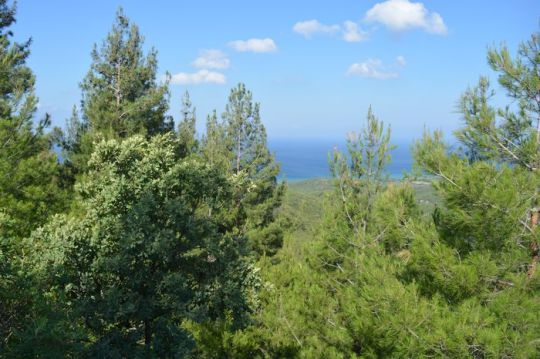
Extensive Archaeological Endeavors
Early Excavations and Discoveries
In 1960, exploration of Turnovo’s historical sites commenced, focusing on the south transverse fortress wall and the Patriarchal complex. Subsequent years saw significant revelations, with 1963 marking the discovery of a small church in the square in front of the Palace and the excavation of a residential district on the west slope of the hill “Momina Krepost.”
Expansion of Excavations
The scope of archaeological endeavors expanded notably after 1966, following a government decree aimed at developing Turnovo as a historical, cultural, and tourist destination. Spearheaded by a Public Committee and involving a collaboration between archaeologists, the Bulgarian Academy of Sciences, and the Archaeological Museum in Turnovo, the project gained momentum.
Focus Areas and Findings
The archaeological focus centered on key sites such as the central capital fortress, the monastery “Velikata Lavra,” and the church “Sveti Dimitur.” Detailed examinations were conducted on Tsarevets Hill, unraveling the architectural complexities of the north and west fortress walls Private Tours Istanbul, along with associated defenses, gates, towers, and dwellings. Particularly significant was the exploration of the Castle of Bulgarian Tzars and the Patriarchate, shedding light on both secular and clerical powers during The Second Bulgarian Kingdom.
Rich Discoveries
The extensive excavations yielded remarkable findings, including over 500 dwellings, 23 Middle Age churches, and a plethora of artifacts. These discoveries provided valuable insights not only into architectural styles but also into the craft industry, lifestyle, and cultural practices of the society during that era.
Unveiling Historical Layers
A crucial aspect of the excavation involved deciphering the stratification of Turnovo’s history, spanning from the Thracian settlement through the early Byzantium town and the early Middle Age settlement, up to the emergence of the capital Turnovo town. Additionally, the fate of the monuments under the rule of the Ottoman Empire was meticulously examined, enriching our understanding of Turnovo’s complex historical narrative.
0 notes